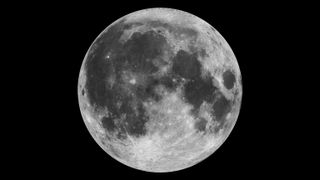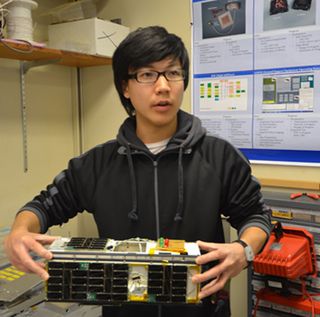
Tiny LunarCubes Could Explore Moon on the Cheap

Ultra-small and lightweight satellites, called CubeSats, have demonstrated their agility over the years to carry out space research in low-Earth orbit, typically using commercial off-the-shelf electronics.
A move is on to consider using these miniaturized spacecraft to further moon exploration — a new class of CubeSat dubbed LunarCubes.
When CubeSats emerged onto the scene, and ideas began to materialize about their uses in Earth orbit, the prevailing thought was “that’s impossible, you’ll never do it,” said Russell Cox, director of research for Flexure Engineering in Greenbelt, Md.
Now that scads of CubeSat missions have been flown or are on the books, the idea of these diminutive spacecraft heading for the moon has taken off, Cox said. [20 Most Marvelous Moon Missions]
More questions than answers
Robotic spacecraft launched by multiple nations, Cox said, have found the moon to be a much more dynamic and complex place than anyone expected. These missions, he said, have generated more questions than answers … so there are many scientific problems where one good, simple measurement could dramatically improve our understanding.
"Lots of people are going to the moon. It’s not all that hard to get there," Cox said. "And every single mission in the last five years has found startlingly new information. There are lots and lots of things to think about."
Get the Space.com Newsletter
Breaking space news, the latest updates on rocket launches, skywatching events and more!
Several things are happening that can advance a LunarCubes program into being.
First, there are numbers of boosters already outfitted to deploy CubeSats into Earth orbit. Second, every geosynchronous Earth orbit (GEO) satellite placement is a potential lunar mission starting point. Also toss in the advent of weak stability boundary transfer orbits from GEO to lunar orbit.
And last, there’s the Google Lunar X Prize — the $30 million competition for the first privately funded team to send a robot to the moon. There could be multiple lander opportunities in the coming years, and they are all looking for science payloads, Cox said. [Photos: Meet the Google Lunar X Prize Teams]

Dirt cheap
"Many people are completely unaware that this capacity is becoming available," Cox said. A trio of science briefings on LunarCubes will be staged between October and April of next year, he added, to provide a thorough introduction to the topic and to start building bridges between science and technical communities.
What’s required for a CubeSat to operate in the deep space environment?
The jump from CubeSats lingering in low-Earth orbit to working in deep space, Cox said, means longer duration missions, taking on higher doses of radiation, and experiencing a more extreme thermal environment.
These are solvable, Cox said. “It’s harder, but it is definitely not impossible. The technology is very much there. You don’t have to invent new technology to make this work.”
But it also means an increase in price to build and test a CubeSat capable of going the lunar distance. The dollar leap would be from an Earth-oriented CubeSat costing a few hundred thousand dollars to a moon-bound version requiring a cash outlay of a few million dollars, Cox said. Still, that’s dirt cheap, he said, in contrast to any lunar mission that has an out-the-front-door price tag of hundreds of millions of dollars.

In a (lunar) swirl
One early proposal for a CubeSat mission to the moon is being spearheaded by researchers at the University of California, Santa Cruz, and the University of California, Berkeley, with an assist from NASA’s Ames Research Center.
This mission would use a mothership to release several CubeSat probes on impact trajectories into the heart of lunar swirls and measure the magnetic field, solar wind flux and dust flux, until the moment of impact.
Lunar swirls are one of the most enigmatic geologic features on the moon. They appear as curlicues of pale moon dust, twisting and turning across the lunar surface in some locations. Understanding their formation has implications for space weathering, lunar surface water phenomena and the history of the lunar dynamo.
Viewed as ideal for this task is the National Science Foundation-funded CubeSat for Ions, Neutrals, Electrons & MAgnetic fields, or CINEMA for short. It was built by UC Berkeley and South Korea’s Kyung Hee University.
CINEMA is one of 11 CubeSats bound for Earth orbit on an Atlas V rocket that carries a hush-hush National Reconnaissance Office primary payload, now scheduled for a September takeoff from Vandenberg Air Force Base in California.

Creative and low-cost ideas
The CINEMA CubeSat is adaptable to conduct some first-of-a-kind science at lunar swirls, for very low cost, said Ian Garrick-Bethell, assistant professor at the Department of Earth and Planetary Sciences at the University of California, Santa Cruz. Such a mission would also showcase the first use of CubeSats beyond low- Earth orbit.
“The strength of the magnetic field and the solar wind flux at the surface of these unique features are key science questions we could answer with a CINEMA-like impactor that measures and transmits this information in the last milliseconds before impact,” Garrick-Bethell said. “All we need is a ride to the moon, or a CubeSat propulsion system that can get us there on our own,” he told SPACE.com.
“I think that once we demonstrate the ability to operate CubeSats in a planetary environment, a wide range of creative and low-cost ideas will start to emerge, potentially opening up planetary exploration to a wider number of participants,” Garrick-Bethell said.
Next generation lunar explorers
“I think lunar CubeSats have much potential,” said Jack Burns, director of the NASA Lunar Science Institute’s Lunar University Network for Astrophysics Research (LUNAR) Center at the University of Colorado, Boulder.
Small satellites with single instruments targeted for specific goals, say, a neutron spectrometer to search for hydrogen in craters near the lunar poles, Burns told SPACE.com, are potentially more cost-effective, scientifically valuable and, most important, can be led by student teams with faculty supervision.
“This will enhance our pipeline of next generation lunar scientists and engineers. Such CubeSats may be the way in which we might continue to scientifically explore the moon in the era of tight budgets,” Burns said. “With new rockets under development that can travel to the moon — like the SpaceX Falcon 9 and NASA’s Space Launch System — and carry CubeSats as secondary payloads, there may also be numerous opportunities to deploy such small instruments in the next decade,” he said.

Surface science
Still in a wait-and-see mode is Clive Neal, a leading lunar explorer at the University of Notre Dame’s Department of Civil Engineering and Geological Sciences in Indiana.
“In order to take the next leap in lunar understanding, we need to get to the surface…I am not sure CubeSats can do that,” Neal said.
There are a few orbital datasets that could still profit lunar science and human exploration, Neal added, such as long-term monitoring of the radiation environment over a number of years, establishment of a communications/surface navigation network, and studying moon-magnetotail interactions.
But Flexure Engineering’s Cox said the Google Lunar X Prize landers could offer LunarCubes a ride down to the moon’s surface. He envisioned using a mortar to lob the small spacecraft from a lunar lander.
“You could also bolt them to the deck of a lander so they could look up into the sky or down at the surface … or you could drop them onto the surface. Just understanding how the exhaust plume from the lander interacted with the soil is an interesting science and engineering question,” Cox said. A deployed rover could also haul several LunarCubes to be scattered away from the exhaust plume onto a pristine lunar site, he said.
“There are a bunch of raw science questions,” Cox said, “and likely plenty of interesting physics going on. There’s a lot of one-off science questions to be explored,” he concluded.
Leonard David has been reporting on the space industry for more than five decades. He is a winner of last year's National Space Club Press Award and a past editor-in-chief of the National Space Society's Ad Astra and Space World magazines. He has written for SPACE.com since 1999.
Join our Space Forums to keep talking space on the latest missions, night sky and more! And if you have a news tip, correction or comment, let us know at: community@space.com.

Leonard David is an award-winning space journalist who has been reporting on space activities for more than 50 years. Currently writing as Space.com's Space Insider Columnist among his other projects, Leonard has authored numerous books on space exploration, Mars missions and more, with his latest being "Moon Rush: The New Space Race" published in 2019 by National Geographic. He also wrote "Mars: Our Future on the Red Planet" released in 2016 by National Geographic. Leonard has served as a correspondent for SpaceNews, Scientific American and Aerospace America for the AIAA. He was received many awards, including the first Ordway Award for Sustained Excellence in Spaceflight History in 2015 at the AAS Wernher von Braun Memorial Symposium. You can find out Leonard's latest project at his website and on Twitter.
